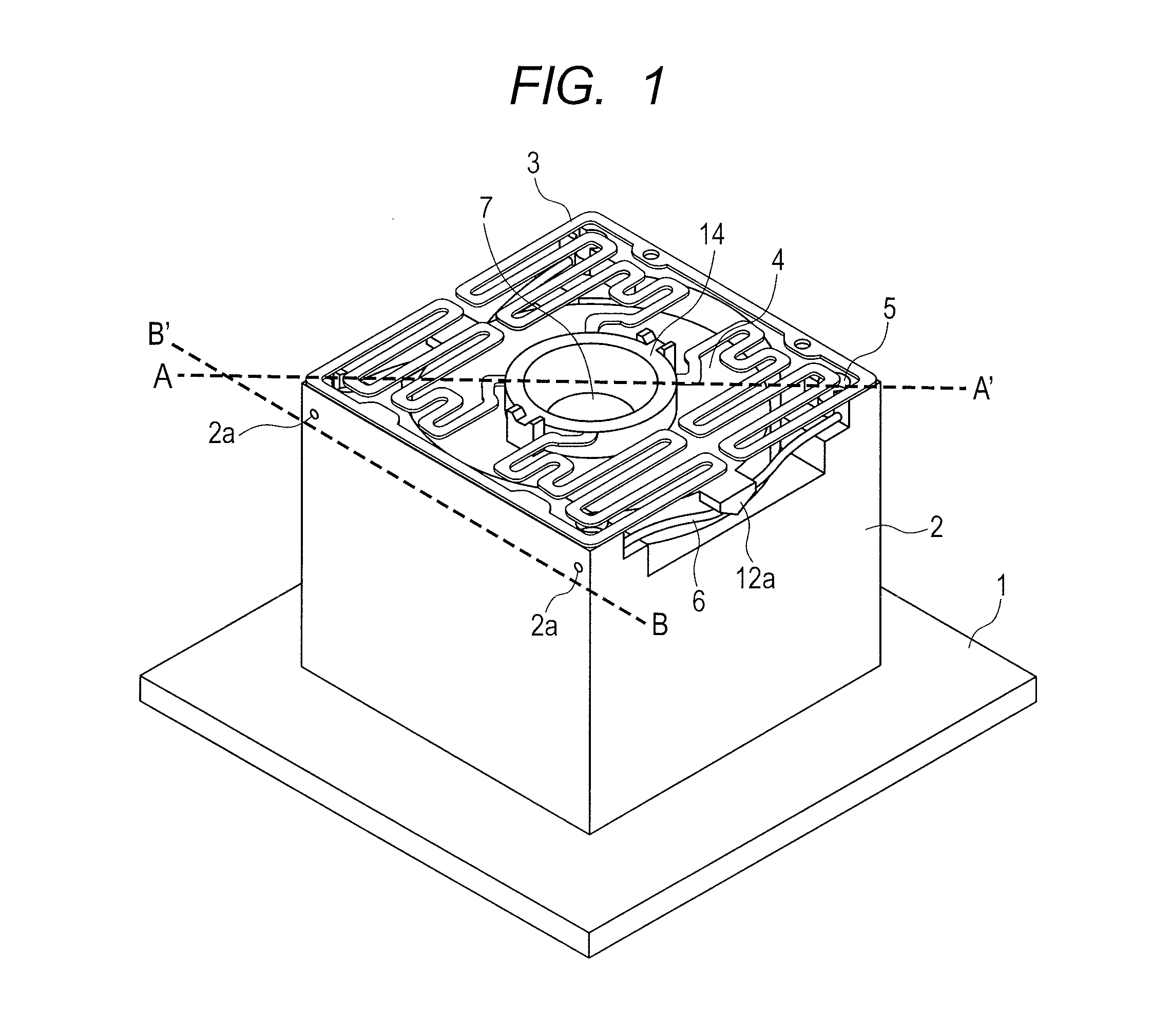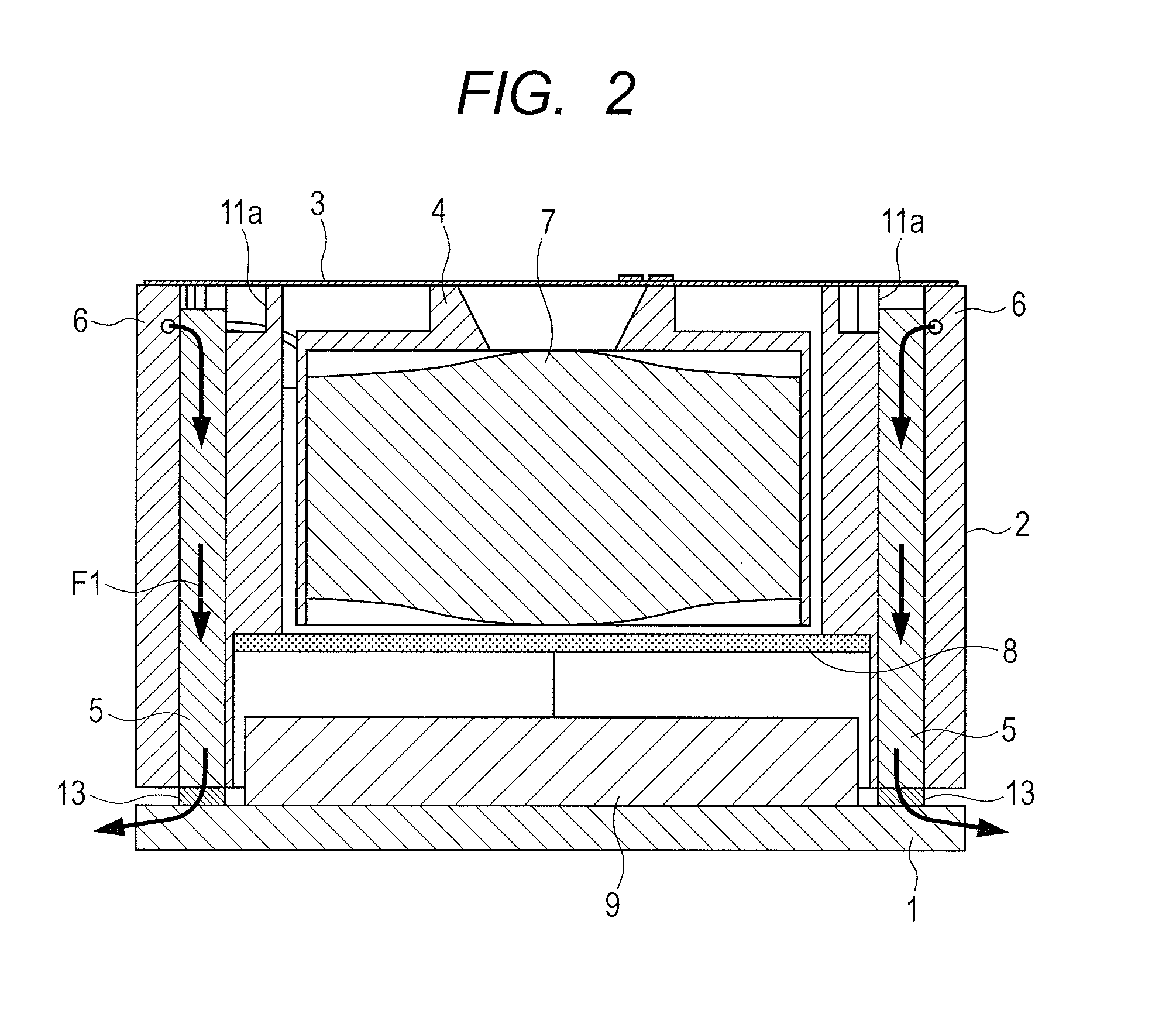Imaging device
a compact, imaging technology, applied in the direction of printers, cameras, instruments, etc., can solve the problems of deteriorating the response of the actuator to the driving operation during cooling, affecting the performance of the actuator, and hardly allowing flexibility for setting the mounting position on the printed board. , to achieve the effect of improving the response rate, improving the heat release property of the shape-memory actuator, and small wiring structur
- Summary
- Abstract
- Description
- Claims
- Application Information
AI Technical Summary
Benefits of technology
Problems solved by technology
Method used
Image
Examples
first embodiment
[0031]FIG. 1 is an explanatory view illustrating a basic structure of a camera module according to a first embodiment of the invention. FIG. 2 is an explanatory view of a vertical section of the structure shown in FIG. 1 taken along a broken line A-A′. FIG. 3 is an explanatory view of a horizontal section of the structure shown in FIG. 1 taken along a broken line B-B′. FIG. 4 is an enlarged view of a region R1 enclosed by a broken line shown in FIG. 3.
[0032]FIG. 1 illustrates a printed circuit board 1, a camera casing 2, an insertion hole 2a of a shape-memory actuator wire, a plate spring 3 for pressurizing a lens holder, the lens holder 4 for fixing a lens 7, and a metal pin 5 which serves to fix a shape-memory actuator 6 while functioning as a conductor wire. FIG. 2 illustrates an infrared filter 8, an image pickup device 9, a solder 13 for bonding the metal pin and the printed wiring, and a flow F1 of the heat generated by the shape-memory actuator 6. FIG. 4 illustrates a contact...
second embodiment
[0038]A second embodiment will be described.
[0039]The heat release means of the second embodiment is different from that of the first embodiment. The different structure will be described hereinafter.
[0040]In the second embodiment, the metal pin 5 and the plate spring 3 according to the first embodiment shown in FIG. 2 are thermally connected. The solid line L1 of FIG. 6 according to the first embodiment indicates the response expressed by the relationship between the temperature and time. Meanwhile, the shape-memory actuator 6 transfers and releases the generated heat to the plate spring 3 as the good thermal conductor via the metal pin 5 in addition to the general heat release only from the printed circuit board 1 via the metal pin 5 to improve the heat release property. Accordingly, the response rate of the actuator may be improved as shown by the broken line L2 of FIG. 6. The heat transferred to the plate spring 3 is brought into contact with ambient air while being released.
[00...
third embodiment
[0042]A third embodiment will be described.
[0043]The actuator of the third embodiment is different from that of the first and the second embodiments. The arrangement and outer appearance of the structure according to the third embodiment are substantially the same as those of the first embodiment. However, the shape-memory actuator 6 is configured to expand and contract under the electric field generated by voltage application, for example, as an ion conduction polymer actuator. It has such feature as small heat generation amount, requiring no consideration with respect to the heat release.
PUM
 Login to View More
Login to View More Abstract
Description
Claims
Application Information
 Login to View More
Login to View More - R&D
- Intellectual Property
- Life Sciences
- Materials
- Tech Scout
- Unparalleled Data Quality
- Higher Quality Content
- 60% Fewer Hallucinations
Browse by: Latest US Patents, China's latest patents, Technical Efficacy Thesaurus, Application Domain, Technology Topic, Popular Technical Reports.
© 2025 PatSnap. All rights reserved.Legal|Privacy policy|Modern Slavery Act Transparency Statement|Sitemap|About US| Contact US: help@patsnap.com



